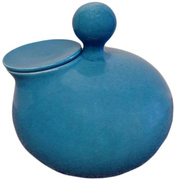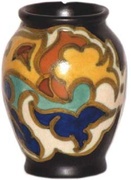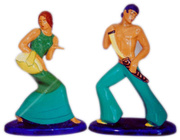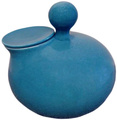This article notes the uses for antique pottery crocks and jars (both historically and at the time the article was published) and important potters who created them, and it describes the difference between stoneware and redware. It originally appeared in the March 1942 issue of American Collector magazine, a publication which ran from 1933-1948 and served antique collectors and dealers.
“Five good old-fashioned stone crocks! Not a nick or a chip on any of them. Look at this little brown one with the cover. Grandma kept her yeast in that. She never fooled around with the store kind. And you neighbors can all remember the ginger cookies and hermits she always kept in those two reddish ones with the splotches on ’em. See that gray one there with the blue posy? That used to be full of green tomato pickles, made as only grandma knew how to make ’em. This big one was her churn. You know some folks pay fancy prices for these old things as antiques, but I’m just here to sell them as honest crocks that will still hold good home-cooked food — if you can get your women folks to make any. How much am I offered ? Half a dollar each? Ten cents! Henry, I’m ashamed of you when I consider all the cookies you had out of them crocks when you wuz a boy.”

An Unusual Stone Crock: Made by Adam Caire of Poughkeepsie, New York, in the last quarter of the 19th Century. Its distinctive feature is the decoration in cobalt blue of a chicken pecking at corn.
This was a country auction. Old Mrs. Tompkins was dead at eighty-five and her children were selling what they did not want of her possessions. Mounted on an empty feed bin in the front yard, auctioneer Graves was turning each piece into a bargain not to be missed, with his quick wit and ready tongue. Gradually the bidding rose until the auctioneer sensed he had reached the limit on the stone crocks and with this, “Sold! at three fifty the lot to Emma Jones,” five pieces of American pottery passed to a new owner.
Now these crocks may have been either early or late 19th-Century vintage, but the chances are that as collectibles any one of them was easily worth what Mrs. Jones paid for the lot.
The scene of the auction was a small farmhouse in southern New England which had sheltered at least four generations of Tompkins. The reddish brown jars with the “splotches” could have come from one of the five potteries that flourished in Norwalk, Connecticut, during the early years of the 19th Century. If the gray crock with the floral decoration also bore the inscription “Manhattan Wells,” it would be reasonable to assume that it was made by Clarkson Crolius of New York and was, consequently, of more value than the eight-sided mahogany Empire table at which Mrs. Jones had cast longing eyes.
The Crolius pottery was founded very early in the 18th Century and continued until 1870. Clarkson Crolius operated it during the first three decades of the 19th Century. A crock or jug bearing his mark or that of other members of this potting family, or of its rival, the Remneys, is worth owning. These two families were New York City potters to the third and fourth generations. In fact, Henry Remney, grandson of the founder, migrated to Philadelphia and there started the business that still bears the family name and still produces stoneware.
But while any collector gets a thrill out of owning a rarity, there are pieces made later and by less renowned potters that are just as satisfying to the eye. Such is the crock illustrated. It was made in Poughkeepsie, New York, by Adam Caire, son of an Alsatian potter who emigrated to America in 1839 and started the pottery which continued under that family name, save for a brief interlude, until the death of Adam in 1896. The latter had a partner from 1856 to 1878, so this piece, marked simply, “Adam Caire, Po’keepsie, N. Y.,” must have been made fairly late in the century. Its desirability is due to its design which, done free hand in cobalt blue, is both original and realistic.
Originally this four-gallon crock may have been a receptacle for butter, for lard, or for storing eggs in water glass (the country method for preserving them against winter scarcity). Present-day uses may range anywhere from a jardiniere to a wastepaper basket. Similarly the stoneware churn which was made, along with other household pieces, in potteries from Maine to Georgia and as far west as Iowa, may serve today’s needs in various ways.
Although the popular term for these humble objects is stoneware, the earliest examples in America were not made of it, but of the softer, more porous redware which is about the first type of pottery known to man. Bricks are one form of it and the pitcher that Rebecca took to the well in Biblical times was undoubtedly another.
As the red clay used was common to most localities, our early potters set up their simple apparatus: a grinding mill for the clay, a potter’s wheel for shaping the object, and a small kiln for firing, and went to work wherever there was demand for household wares. This was about everywhere in the Thirteen Colonies and later in the United States as the large check list in John Ramsay’s excellent book, American Potters and Pottery, shows. The redware products in household use were glazed, either on the outside or inside or both. Sometimes the potter inscribed his name in the soft clay; oftener the piece was unmarked.
Stoneware, on the other hand, quite often bears the maker’s stamp. Its composition, as the name implies, is very hard. It is made from a fine, dense clay and being fired at a high temperature attains a consistency akin to hard-paste porcelain. The glaze is obtained by throwing ordinary salt into a kiln full of the ware at high heat.
As there were deposits of this special clay in both New Jersey and New York, potters in these two colonies were the first to make household utensils in this ware. There are records of such potteries in the late 17th Century, but though hardness and durability were distinct assets, the appeal of stoneware to the general public did not begin until after the American Revolution. Even then redware was far from becoming an also-ran. Potters all over the country kept on making it in various forms, along with stoneware, right down to the beginning of the 20th Century.
This article originally appeared in American Collector magazine, a publication which ran from 1933-1948 and served antique collectors and dealers.

 Stuart Lonsdale Explains the History and Design of Gouda Pottery
Stuart Lonsdale Explains the History and Design of Gouda Pottery
 Red Wing Beyond the Crock: Larry Roschen on the Stoneware Legend’s Dinnerware
Red Wing Beyond the Crock: Larry Roschen on the Stoneware Legend’s Dinnerware Stuart Lonsdale Explains the History and Design of Gouda Pottery
Stuart Lonsdale Explains the History and Design of Gouda Pottery Cowan Art Pottery of the Art Deco Era
Cowan Art Pottery of the Art Deco Era StonewareStoneware is the roughhewn cousin of porcelain. Like porcelain, it is fired…
StonewareStoneware is the roughhewn cousin of porcelain. Like porcelain, it is fired… Mari Tepper: Laying it on the Line
Mari Tepper: Laying it on the Line Nice Ice: Valerie Hammond on the Genteel Charm of Vintage Canadian Costume Jewelry
Nice Ice: Valerie Hammond on the Genteel Charm of Vintage Canadian Costume Jewelry How Jim Heimann Got Crazy for California Architecture
How Jim Heimann Got Crazy for California Architecture Modernist Man: Jock Peters May Be the Most Influential Architect You've Never Heard Of
Modernist Man: Jock Peters May Be the Most Influential Architect You've Never Heard Of Meet Cute: Were Kokeshi Dolls the Models for Hello Kitty, Pokemon, and Be@rbrick?
Meet Cute: Were Kokeshi Dolls the Models for Hello Kitty, Pokemon, and Be@rbrick? When the King of Comedy Posters Set His Surreal Sights on the World of Rock 'n' Roll
When the King of Comedy Posters Set His Surreal Sights on the World of Rock 'n' Roll How One Artist Makes New Art From Old Coloring Books and Found Photos
How One Artist Makes New Art From Old Coloring Books and Found Photos Say Cheese! How Bad Photography Has Changed Our Definition of Good Pictures
Say Cheese! How Bad Photography Has Changed Our Definition of Good Pictures Middle Earthenware: One Family's Quest to Reclaim Its Place in British Pottery History
Middle Earthenware: One Family's Quest to Reclaim Its Place in British Pottery History Fancy Fowl: How an Evil Sea Captain and a Beloved Queen Made the World Crave KFC
Fancy Fowl: How an Evil Sea Captain and a Beloved Queen Made the World Crave KFC
I have a brown jug with the name “Calvin Moore” stamped on the top. It is very unusual and has a “picture” on it of a corn field and a tree stump with an ax in the stump. I can not find any info or jugs like it. Any help would be great. My Grandmother was from New Hampshire, and moved to Ohio in the 50’s.( this any help). Thank you
I have a stone canning jar with a wire handle (about a quart size) it has a Patent that says July 13, 1909 by Jos.H Sohramm. Just curious about it, it’s been in the family for a long time.
I have 6 in. tall beanpot (brown top, tan bottom) with one handle in excellent condition. On the bottom, there is a blue 5 pointed star inside a circle; inside the star is the number 2. There also looks like the letter E or B punched (etched?) on the bottom as well. Can you help with age, value? Any info would be very appreciated. Many thanks.
I have a large brown crock (approx. 12 inches high) with the following stamped on the bottom: R. R.P. Co.
Roseville, O USA. Also a black crown with the number 3 inside a circle on the crown. Is this crock connected with the Roseville Pottery Co.? Would appreciate any information and a value
Trying to find information on The Buckeye Pottery Company in Macomb Ill.
regarding a 30 gallon crock with the Stag Head Mark is it rare? I have not found that mark when looking on the internet very often. How much would it be worth approx. very good condition?
I have a 5 gallon stone crock with metal lid. It has a circle with a star in it and another circle with a #8. It has the blue cobalt on it. I was trying to find out exactly what it is and if it is worth anything. I know it is at least 100 years old.
Blue Indian head is the logo of Louisville Pottery in Kentucky. Their line called Cherokee was made in early 1900’s. Company is still in business. Identify marks thru ‘Lehner’s Enclyclopedia of US Marks on Pottery, Porceline and Clay” available on Amazon.
i have a large crock with the number 8 inside what appears to be a crown. can you tell me anything about my find?
I have a butter churn with lid only. It is in good condition. It has blue crown with a 4 in it and usa on bottom. How old is it and whats it worth?
We found an 8 gallon crock with a completely round bottom. There is a round hole in the bottom. The side is glazed until about 4 inches from the bottom. There is an 8 in blue in the non glazed area. What type of crock was this and what was it used for?? Thanks
I inherited an old #10 stone crock when my mom passed away in ’97. It’s a creamy white inside and out and the logo on it is a circle with blue stars around the border and a blue Indian head in the center. What can you tell me about this crock? I’m currently trying to make pickles in the crock and it has some chips in the glaze so I’m getting a salty crust on the outside of the crock (which I totally expected it to do but you use was you’ve got!). Thank you for your time!
I did alot of research and found out that the blue crown with a number in it may be a Robinson Ransbottom crock. I have one with a number 10 meaning its a 10 gallon crock. They sell on ebay for anywhere between 100-300 for this size. Hope it helps.
I have a three gallon crock with a blue Eagle stamp on it. Approx. 2 inches square. The Eagle with wings spread has a U on the tip of the left wing and an S at the tip of the right wing. Underneath the Eagle is a banner strip with some letters that are difficult to make out. Possibly an M A then some type of insignia possibly of two crossed rifles then the letters A R. Is it possible that it could be some type of military mark? I can’t seem to locate it anywhere. Maybe you have seen it before.
I just bought an old looking crown crock and just noticed the ink is black instead of blue. What does that mean?
Thanks for any help.
I have a crock that has a small Dog towards the top with the name of BOSCO underneath it in a rectangle box and the number 12 under that all in the color blue it is in excellent condition can not find any info on it any ideas. Thank you
I have a 5 gallon glass water bottle w/ 1776 on the bottom and a large eagle on the front of it. Does anyone know anything about it?
I have 3 crocks. The small one is approximately 7″ x 7″, no specific markings. The other one is approximately 9″ x 9″, it has a blue number 2 on it. Both crocks are dark brown inside and brown and white on the outside. . . top half brown, bottom half is white. The larger on has a gold strip that separates the two colors. The third crock is a jug. It is white on the bottom and dark brown on the top and has a cork in it. On the jug is a circle, inside the circle is a 5 point star and inside the star is a number 4 . . . the circle, star, and number are drawn in blue. The jug is about 18″ high by 10″. Are any of the items of value? Thank You.
I have a 30 gallon crock with a “bubble 30” inside a blue heart. It has two grips on either side which are part of the crock. I find no other markings on the crock and it is a solid color. Any info you can give me would be appreciated.
I have a crock with YORK and a big P in an arrowheadish shape. I see you have answered that for question number 10. How do I find the answer?
I have a crock that I want to use for sauerkraut that is from the “Western Pottery Company” in Denver. Do I need to be concerned about lead being used it the glaze? I can’t find information anywhere. Thanks
I have a butter churn with the number 2 on it but the top of the 2 is cut off. Below the 2 there are two thick blue circles. There are spots that look like the blue used for the circles actually smeared. One place is on a circle smearing down. The other places are lower on the churn as if the blue paint was on the hand of the maker. There are no other markings. I can not find anything online that matches this churn. If you can tell me anything I would appreciate it very much.
I have a crock numbers are 270s looks like a 5 gal water crock I just wanted to know the age thanks dave sharon
I have a 15 gallon crock with an eagle sitting on some type of banner. Its wings are spread. On the left wing is the letter U. On the right wing is the letter S. Everything is in black. Does anybody know who made it.
We inherited a crock and have no clue about the value, origin, maker. It’s plain, no markings except for a “10” impressed in the side, near the handle, just under the rim. How do I identify a crock with minimal markings?
What would a butter churn with a 3 inside a star be worth? Great condition with the wood handles and wood paddle.
I purchased an old crock butter churn. The only mark that I can find is a #3 inside a star inside a circle in blue. The lid has a 3 etched in also. Was wondering if you knew where and when it was made and by what company. Thank you.
I have a solid Brown 4 gallon Croc with the number 5 engraved on the front of it and another with a light tan bottom with dark brown top 5 gallon Croc with a number 5 stamped on it was wondering the value of these
I have a quart jar with a cork in it an it has the letters LABLagoy.on the side.I would love to know about it
dug up several small crocs near S Main and Thornton St in Akron Ohio. 7″ X 4″ . two tone Brown over white with a castle type inside top and the words THE LAYMAN. the is above and layman under, and under that it says patent applied for. Can’t find anything on it. Had met a man named Bob Koster , who was an authority but can’t find him. he did live in Barberton
Why would a pottery pitcher have a hole in the handle and also the side and then one that looks like a duck foot cut out of the bottom, just to look at it, every thing looks great, I can send a photos of this item. Just curious I won it in an auctions.